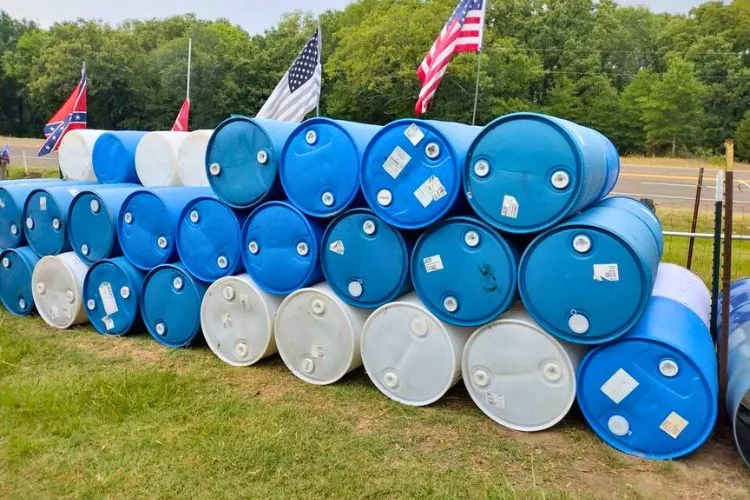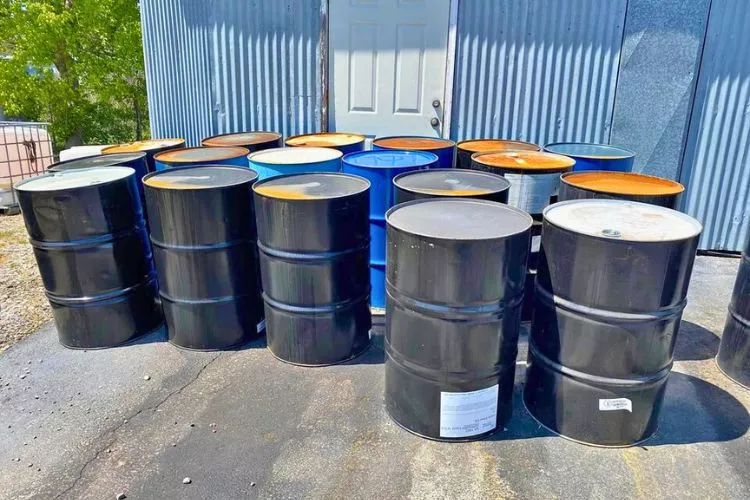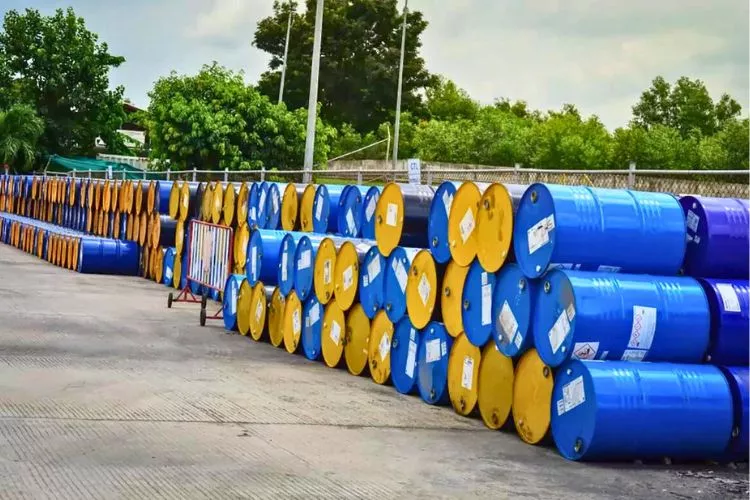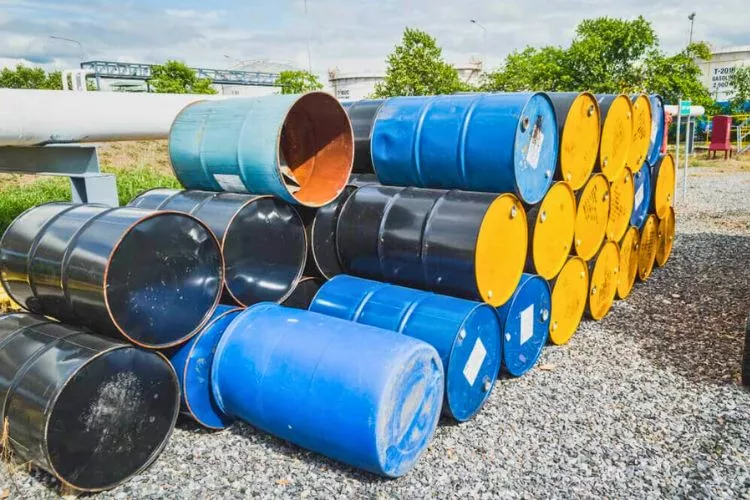
You’ll find step-by-step instructions, helpful tips, and easy-to-follow advice to make the cleaning process simple and effective.
How to clean a 55 gallon drum?
While learning how to clean a 55 gallon drum, you can adopt several effective methods depending on their condition and your available resources.
In this comprehensive guide, we’ll walk you through different approaches to ensure your drum is spotless and safe for usage.

Baking Soda Method
Baking soda is a potent, non-toxic cleaner that can effectively deodorize and cleanse your 55 gallon drum.
- Preparation: Mix your drum with hot water and add approximately one cup of baking soda. Allow this solution to sit for several hours, preferably overnight.
- Scrubbing: Drain the water and use a long-handled brush to scrub the inner surfaces. The soaking process should have loosened the residues making them easier to remove.
- Rinsing: Rinse thoroughly with clean water to remove any remaining residue.
Vinegar Cleansing
Harnessing the cleaning power of vinegar could immensely service your 55 gallon drum, especially for removing stubborn calcified deposits.
- Preparation: Fill the drum with a 1:1 water and white vinegar solution, then let it sit overnight.
- Scrubbing: Use a scrub brush to clean the inner surfaces. The vinegar solution should have softened the hardened deposits.
- Rinsing: Thoroughly rinse the drum with water to ensure no vinegar remains.
Commercial Degreasers
You might need to resort to commercial degreasers for incredibly stubborn or oily residue.
- Application: Follow the instructions on your chosen degreaser’s packaging for the best results. Generally, this involves diluting the degreaser with water and adding it to the drum. Allow it to sit as directed by the product instructions.
- Scrubbing: Scrub the drum thoroughly using a long-handled brush.
- Rinsing: Rinse out the drum meticulously to remove all traces of the degreaser.
Chlorine Bleach Cleaning
Chlorine bleach is especially effective when sanitizing your drum or removing stubborn stains or smells.
- Preparation: Add one cup of bleach to four to five gallons of water inside your drum.
- Mixing and Waiting: Swish the mix around the drum carefully to reach all areas, and leave it to sit for 15-30 minutes.
- Rinsing: Rinse away the bleach fully with water until no smell persists.
- Note of Caution: Always wear protective gear while handling bleach.
Soap and Water Method
This method is great for general cleaning and won’t harm the drum material.
- Preparation: Fill the drum with hot water and add a generous dish soap or a mild detergent.
- Scrubbing: Agitate the water to produce soap suds, then use a brush to scrub the interior surfaces of the drum.
- Rinsing: Rinse the drum with warm water until no soapy residue remains.
Note: For each method, drying your drum is fundamental. Inviting air inside the drum to circulate thoroughly after rinsing helps prevent odor caused by bacteria and mildew proliferation.
Drying
After cleaning your drum by any method, drying is necessary to prevent bacteria and subsequent odour growth.
- Drainage: Invert the drum and let all the water drain out.
- Air drying: Allow the drum to dry out in a well-ventilated area with sufficient air circulation, or use a blower if available.
How to clean out a 55-gallon oil drum?
Cleaning a 55-gallon oil drum can be a challenging task, but with the right approach and techniques, it’s achievable.
Here’s a step-by-step guide to help you clean your oil drum:

- Empty the Drum: Begin by emptying the drum and saving any remaining oil for recycling or proper disposal.
- Hot Water Method: Fill the drum with boiling water, or add water to it and heat it until it boils. This step helps to loosen and dissolve the residual oil and contaminants in the drum.
- Degreaser Application: Use a commercial degreaser to remove the challenging oil residues. Follow the instructions on the degreaser’s packaging for dilution, application, and wait time.
- Scrubbing: After the degreaser has had enough time to work, use a long-handled brush to scrub the interior surfaces of the drum. Ensure you reach all areas inside to remove any remaining oil and contaminants.
- Rinsing: Rinse the drum thoroughly with water to remove all traces of the degreaser and oil residues. Repeat this step if necessary until the drum is completely clean.
- Drying: Leave the drum to dry in a well-ventilated area, ensuring that it is completely dry to prevent any bacteria or mildew growth from forming.
How Much Bleach Do I Add To A 55-Gallon Water Barrel?
To add bleach to a 55-gallon water barrel for purification, you should use approximately 3/4 teaspoon of bleach per gallon of water.
So, for a 55-gallon water barrel, you should add approximately 41.25 teaspoons (about 13.75 tablespoons) of bleach. If you are using a stronger bleach concentration, follow the guidelines provided by the EPA .

It’s essential to use regular, unscented household bleach containing 6% sodium hypochlorite to purify your water. Mix the bleach with the water thoroughly and allow the treated water to stand for at least 30 minutes before using it.
The water should have a slight chlorine odor after the process. If it doesn’t, repeat the dosage and let it stand for 15 minutes before using.
How much bleach do I need to disinfect a 55-gallon drum?
To disinfect a 55-gallon drum, mix 1 tablespoon of unscented household bleach per gallon of water. Therefore, add about 55 tablespoons of bleach (equivalent to 3.44 cups or approximately 27.5 fl. oz.) to 55 gallons of water in the drum.
Ensure the chlorine bleach you’re using has a 6% sodium hypochlorite concentration.
After adding the bleach:
- Mix the water thoroughly and let it sit for at least half an hour to ensure effective disinfection.
- Before using the water, check for a slight chlorine odor.
- If it’s absent, repeat the treatment, and wait for another 15 minutes.
How much bleach do I need to disinfect a 55-gallon drum?
Cleaning chemicals out of plastic water barrels may require a few steps to ensure thorough sanitation. Here is a recommended process based on the sources found:

- Empty the barrel: Empty the plastic barrel of any remaining chemicals and dispose of them according to proper guidelines and waste disposal procedures.
- Flip the barrel: If small enough, place it upside down on a suitable surface, such as a trash can.
- Rinse with water: Use a hose or pressure washer to thoroughly rinse the barrel’s interior with clean water.
- Use a cleaning solution: Add a mixture of water, castile soap, and distilled vinegar to the barrel, or try mixing 1 tablespoon of bleach per one gallon of water. If the lid isn’t removable, fill the barrel halfway and add one cup of bleach. Make sure to use protective gear when using bleach.
- Scrub: Use a long-handled brush or other suitable cleaning tools to scrub the interior surfaces of the barrel to remove any remaining residues.
- Rinse again: After scrubbing, rinse the barrel thoroughly with clean water to remove any remaining chemicals and cleaning agents.
- Dry: Leave the barrel to dry in a well-ventilated area before using it for water or other purposes.
Remember that this process may vary depending on the type of chemicals previously stored in the barrel. Always check the barrel’s labeling to ensure compatibility with the intended cleaning agents and methods.
Conclusion:
Cleaning a 55-gallon drum is indeed a task that requires careful approach and diligence. The method chosen to clean the drum largely depends on the kind of residue it holds and the material it is made from.
Common household items such as vinegar, baking soda, bleach, and dish soap can often be enough to restore the cleanliness of a drum.
When dealing with stubborn residues like oil, using a commercial degreaser combined with a thorough scrubbing and rinsing can be a more effective approach.
Similarly, dealing with chemical residues might require using specialized methods or professional help to remove all contaminants, and the drum is entirely safe for reuse.
Whether you’re sanitizing the drum for water storage, preparing it as a barbecue pit, or getting it ready to store other materials, a clean drum is essential.
In all cases, safety precautions such as wearing protective gear and ensuring proper ventilation should always be followed.
Finally, we hope that this guide has provided accurate and practical instructions on cleaning a 55-gallon drum that will aid you in maintaining it in the best possible condition, irrespective of its intended use.


